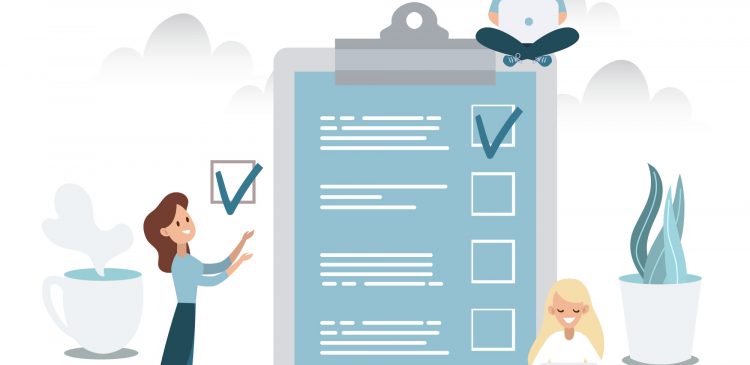7 Tips for A Successful Product Feedback Survey

Are you looking for quick feedback about your company’s products? If this is the case, you’d do well to create a comprehensive product feedback survey. A survey that your customers can take shortly after their purchase is a valuable tool your company can use to further your product improvement.
It also will show that customer satisfaction is a top priority for your organization. This is sure to get customers to think of your company in a positive way, which in turn will make them think of you the next time they need products or services you offer.
Best Practices for Creating A Product Feedback Survey
1. Keep it short
That’s right, these surveys are much better if they’re kept on the short side. People are more likely to read through the questions and finish the survey if it’s to the point and they can get through it quickly. The best product feedback surveys are between 10-20 questions long and are in plain language that a broad audience will be able to understand. The important thing is that you get down what their main perspective is on the product. If you don’t know where to start, don’t worry – we have compiled a list of some of the best questions to include in your product feedback survey.
It is beneficial to give an idea of how long the survey will take to complete. You can have some beta testers take the survey and record how long it takes for a good estimate. Put this estimate in the introduction to your product feedback survey. Respondents will appreciate that you value their time and are being honest about expectations.
2. Ask open-ended questions
Questions that are open-ended get people to give more thoughtful responses. When you include open-ended questions in your survey, you’ll have more of the picture behind your customers’ buying motivations and what they think of your products. You won’t need to make any guesses on what is meant by a “yes”, “no” or “mostly satisfied” type of answer. You can gather data from these details that will help you pinpoint any problem areas and address them more efficiently.
Though you may want to flood your product feedback survey with this type of question, you don’t need more than around two or three. The variety makes it easier to stay focused. You can use this opportunity to ask things like “What can we do to make this a better product?” and “How can we improve on this?”. You can ask about specific aspects of a product, such as if it matches up to how it’s being advertised, if it’s appropriate for its intended use, how easy and convenient it is to use, etc.
3. Let them know what’s in it for them
People tend to want to help more when they know exactly why someone is asking for their help. They have a goal in mind and typically don’t mind helping out if it’s for the good of the company. However, they’re more likely to offer their assistance when it’s clear that they’ll be getting something in return.
Wording is everything in terms of what you’re asking customers to do. For example, the Xerox Mindfulness Experiment studied the effectiveness of different phrasing. When the word “because” was used, it yielded a much more positive response than asking a question without it.
We all like to have reasons behind what we do. Keep this in mind as you draft your product feedback survey text and you should see good results. Go a step further and ensure that customers know they’re getting something valuable back from answering the survey. If they know that the feedback they give will lead to product improvements and enhancements, it’s a far greater driving factor than pretty much anything else.
4. Capture any partial responses
As you create your product feedback survey, you should make it so that the provider or software will keep track of any partial responses. The software needs to record this in the instance you have some people who don’t make it all the way through. You wouldn’t want to miss out on their valuable feedback, regardless of how much of the survey they’re able to complete.
If your surveys contains a larger number of questions, it’s especially a good idea to put your high priority questions right at the beginning. You stand a greater chance of getting useful responses to them if you do so. Also, if you can include two product aspects you’d like feedback on in one question without it being confusing, you should make an effort to do this.
5. Include “other” in your multiple-choice questions
If you decide to use some multiple-choice questions, you should always include an “other” response. You’ll get unexpected answers that will give you insight into some areas you might not have thought about. The customer’s angle is of course different than the manufacturer’s or retailer’s angle, so it would be worthwhile to allow for answers you wouldn’t get otherwise.
This also helps you to avoid unintentional bias when it comes to your answers. You don’t want to skew the results due to having limited room for responses. For this reason, it’s best to make each question as direct as possible so that there isn’t any doubt as to what you’re asking about. Your customers certainly will be pleased as they can offer up exactly what’s on their minds about your products.
6. Find customer advocates to test your product feedback survey
As mentioned previously, it’s ideal to have some people test out your survey before you release it to anyone who purchases your products. Find several customer advocates who are willing to take the survey to test it out first.
Start out with 5-10 people as this can help you determine the quality of the answers and figure out if you should rephrase questions in order to get better insight. A pilot test will provide you with information such as how well users understand what you want them to do, that the questions are clear, and that the technology itself is working. This way, you can analyze the responses and response rate with ease. If you’re not getting enough responses or not enough data from the answers, take the time to revise questions and then do another pilot test.
7. Ask for feedback from customers after the survey
This request doesn’t have to be yet another survey for them to provide you with adequate feedback. You can just put a short request at the bottom of the product feedback survey to be notified if there are any tech issues or what they thought of the survey in general.
You might have a rating plug-in to allow them to rate how they liked it. Then if you notice you’re getting a lot of unfavorable feedback about the survey early on, you have the benefit of that outsider’s perspective so you can fix what needs to be fixed. You can continue on with getting the feedback that will only help your company.
Conclusion
The process of putting together a product feedback survey can be fun and rewarding. Keep in mind your audience, what you want to get from the survey responses, and how you can put your customers at ease with simple and clear questions and by making it clear what they’ll get out of taking the survey. Set up an ideal transaction that will be a win-win for everyone with the great feedback you receive.





